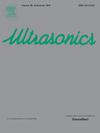Adversarial learning for beamforming domain transfer in ultrasound medical imaging
IF 3.8
2区 物理与天体物理
Q1 ACOUSTICS
引用次数: 0
Abstract
Beamforming, the process of reconstructing B-mode images from raw radiofrequency (RF) data, significantly influences ultrasound image quality. While advanced beamforming methods aim to enhance the traditional Delay and Sum (DAS) technique, they require access to raw RF data, which is often unavailable to researchers when using clinical ultrasound scanners. Given that Filtered Delay Multiply and Sum (F-DMAS) is known to provide superior image quality compared to conventional DAS, this study introduces the idea of employing generative adversarial networks (GANs) that transform plane wave DAS images into ones resembling those produced by F-DMAS. We validated the adversarial approach employing three different architectures (traditional Pix2Pix, Pyramidal Pix2Pix and CycleGAN) using full-reference metrics: Root Mean Square Error (RMSE) and Peak Signal-to-Noise Ratio (PSNR). We further propose employing a texture analysis to validate consistency between the generated images and target images, using 27 first-order and second-order parameters; contrast enhancement was evaluated using the Contrast Improvement Index (CII), and clinical relevance was determined through expert qualitative evaluation. The adversarial methods were also compared with traditional image enhancement methods, such as contrast limited adaptive histogram equalization (CLAHE) and histogram matching. The image similarity metrics between all methods were comparable, with the Pyramidal Pix2Pix GAN method showing the best values compared to traditional techniques and other generative models (PSNR = 18.0 ± 0.6 dB, RMSE = 0.126 ± 0.008). The texture features proved to be a clear discriminant between traditional methods and generative models, with values much closer to the target F-DMAS image for the generative models. All employed methods showed an improved contrast over original PW DAS images. A clinical evaluation was then employed to assess the contribution of the generated images compared to the original ones and to distinguish which generative model provided the best qualitative images. The proposed generative adversarial approach proves to be a viable option for enhancing B-mode ultrasound images when there is no access to raw RF data and demonstrates how texture features can be employed to validate deep learning generative models.
超声医学成像中波束形成域转移的对抗学习
波束形成,从原始射频(RF)数据重建b模式图像的过程,显著影响超声图像质量。虽然先进的波束形成方法旨在增强传统的延迟和求和(DAS)技术,但它们需要访问原始射频数据,而在使用临床超声扫描仪时,研究人员通常无法获得这些数据。鉴于已知滤波延迟乘法和(F-DMAS)与传统DAS相比可以提供更好的图像质量,本研究引入了使用生成对抗网络(gan)的想法,该网络将平面波DAS图像转换为类似于F-DMAS产生的图像。我们使用全参考指标:均方根误差(RMSE)和峰值信噪比(PSNR)验证了采用三种不同架构(传统Pix2Pix,金字塔Pix2Pix和CycleGAN)的对抗方法。我们进一步提出使用27个一阶和二阶参数,采用纹理分析来验证生成图像与目标图像之间的一致性;采用对比改善指数(contrast Improvement Index, CII)评价对比增强效果,通过专家定性评价确定临床相关性。并将对抗方法与传统的图像增强方法,如对比度有限自适应直方图均衡化(CLAHE)和直方图匹配进行了比较。所有方法之间的图像相似性指标具有可比性,与传统技术和其他生成模型相比,金字塔Pix2Pix GAN方法显示出最佳值(PSNR = 18.0±0.6 dB, RMSE = 0.126±0.008)。纹理特征被证明是传统方法和生成模型之间的明显区别,生成模型的值更接近目标F-DMAS图像。所有采用的方法都比原始PW DAS图像的对比度有所提高。然后采用临床评估来评估生成的图像与原始图像的贡献,并区分哪个生成模型提供了最好的定性图像。当无法访问原始射频数据时,所提出的生成对抗方法被证明是增强b型超声图像的可行选择,并演示了如何使用纹理特征来验证深度学习生成模型。
本文章由计算机程序翻译,如有差异,请以英文原文为准。
求助全文
约1分钟内获得全文
求助全文
来源期刊

Ultrasonics
医学-核医学
CiteScore
7.60
自引率
19.00%
发文量
186
审稿时长
3.9 months
期刊介绍:
Ultrasonics is the only internationally established journal which covers the entire field of ultrasound research and technology and all its many applications. Ultrasonics contains a variety of sections to keep readers fully informed and up-to-date on the whole spectrum of research and development throughout the world. Ultrasonics publishes papers of exceptional quality and of relevance to both academia and industry. Manuscripts in which ultrasonics is a central issue and not simply an incidental tool or minor issue, are welcomed.
As well as top quality original research papers and review articles by world renowned experts, Ultrasonics also regularly features short communications, a calendar of forthcoming events and special issues dedicated to topical subjects.
 求助内容:
求助内容: 应助结果提醒方式:
应助结果提醒方式:


